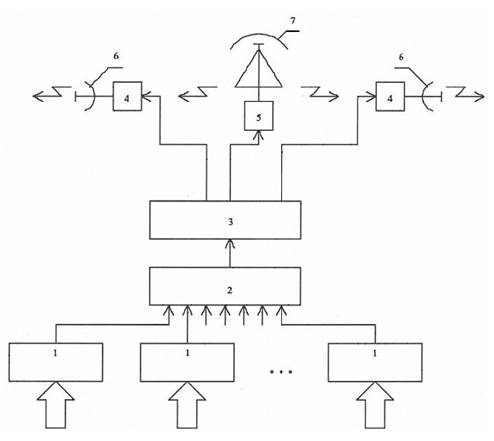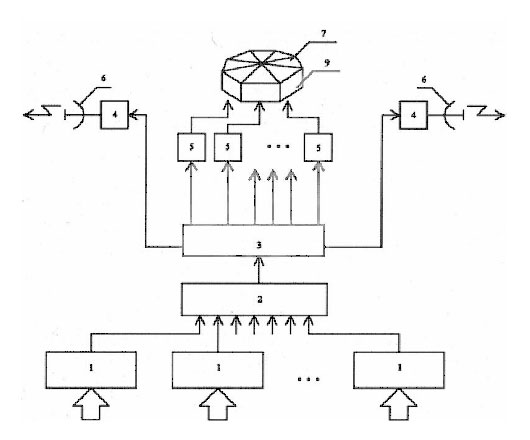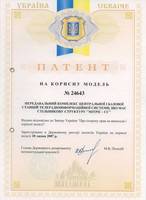Transmitting Complex of the Multimedia System Central and Base Stations Having Cellular Structure "MITRIS-CS"
UKRAINIAN PATENT № 24643, 10.07.2007
P. Ksenzenko, M. Boichenko, P. Himich, A. May, V. Yakimenko “ROKS”-company
The invention concerns to special microwave communication technics which provides data transfer and reception on a radio communication channels. Devices in which the transfer path in the field of microwave frequencies (MW) is executed by a principle of single-channel transmitters powers addition by means of the multiplexers formed by channel filters which are established on each of transmitters outputs, and by ferrite circulators (1,2,3) system are known. Thus frequencies bandwidth which one channel borrows, - nearby 20 MHz , and a frequencies grid step between the next channels – 28 MHz . On frequency 12 GHz channel filters with necessary characteristics can be executed on structures with high quality factor, for example, in the waveguide filters or filters on dielectric resonators form. Lack of the specified devices is that the filters used in transmitters are dear and complex in adjustment (each of channel filters demands individual adjustment), and transmitters quantity to equally radio channels quantity. With the purpose of signal losses prevention the bulky and dear microwave transmitters block should be located near to the transmitting antenna that demands significant capital expenses at equipment installation. Moreover, at relaying a multichannel signal on other base station (BS) the complete set of transmitters and multiplexers should be repeated. At system installation it configuration change (change of the radio channels order and frequencies) is realized with greater difficulties. In most of the known device which has the same purpose as declared is included the programmed converter-composer of an intermediate frequency group signal which is connected to frequency modulating and transmitting blocks.
The transmitter, in turn, is connected to the antenna (4). In the specified device, unlike resulted earlier, for several channels transfer the group broadband transmitter is applied. The transmitter represents the broadband powerful frequency upconverter (BUC) which is used for an intermediate frequencies spectrum convertion in a microwave range and corresponding output signal amplifying. To the reasons which interfere with achievement of expected technical result at use of the known device the impossibility of reception zone expantion maintenance for repeaters in particular concerns. Repeaters cannot be placed on distances from the central station ( CS ) which exceed the service zone size (they should be placed inside of a cell). For reception of a communication opportunity with next BS it is necessary to use fiber-optic communication lines ( FOCL ) or cable lines. The lining of cables or FOCLs is associated with significant capital expenses and in the generated city infrastructure - is simply impossible. Thus, to solve a task in view, i.e. to expand a service zone of all cellular system and to increase quantity of subscribers by means of the specified device (prototype) it is impossible. The task in view is solved owing to a method according to which the declared device gets the combiner-equalizer which N inputs incorporates to outputs N quadrature modulators, and on an output is connected to an input of a multichannel power divider which by N outputs is connected with N inputs of the radio relay transmitters connected to radio relay antennas, and on M outputs is connected with M broadcast transmitters, thus everyone broadcast transmitter is connected to the antenna, and quadrature modulators carry out modulation QPSK, QAM or COFDM, adjustment of channels frequencies and signals spectra formation in an intermediate frequencies range, broadcast and radio relay transmitters work within the limits of the same frequencies range, and at M broadcast transmitters each of them is connected to M sector antennas which form antenna system. Proceeding from told, it is possible to approve with what exactly connection of the resulted attributes and also set of essential attributes of a transmitting complex provide occurrence of invention new technical opportunities which consist in essential increase in a service zone (a cover zone of cellular system) and increase in total of network users (subscribers) due to not only increases in the service zone area, but also prevention of a radioshadow sites occurrence. The decision of the given problem for existing (classical) multimedia systems MVDDS (" MITRIS ") probably exclusively by increase in transmitters power and height of antennas raising, and also increase in antennas gain factor, etc. These measures lead to growth of capital expenses and ecological pollution of territories which adjoin to a transmitter installation place. However, even these measures do not allow in conditions of greater cities with their multi-storey building to prevent radioshadow sites inside of a service zone. Potential subscribers who are within the limits of a radioshadow sites cannot be served by such system. The decision of the specified problem probably by construction of multimedia system in the cellular structure form consisting of set BS which incorporate with each other and with CS defining operation algorithm as all multimedia system.
Transmitting complex CS and BS except for the transmitter and antenna system which carry out service of own cell should have a transmitting radio relay systems quantity which carry out communication CS with BS and BS with BS by means of radio relay lines ( RRL ). As the volume of the digital information which compose of multiprogramme TV, Internet, and other services is very great for its transfer to the subscribers who are settling down inside of service zones (cells) CS and BS it is necessary to use broadband radio channels and a greater general bandwidth of the frequencies borrowed on air. The same information volumes are transferred also in a direction from CS to several BS . Considering told, on the foreground the problem of a frequency resource economy acts. The essence of the offered invention is explained by means of Fig .1 and Fig .2 on which in the block diagrams form transmitting complexes with elements making them and their interrelation are represented.
The transmitting complex of the multimedia system central and base stations having cellular structure " MITRIS-CS " (Fig .1) includes quadrature modulators 1 which are connected by the outputs with N inputs of the combiner-equalizer 2, it, in turn, is connected by an output to an input of a multichannel power divider 3 which on an output is connected with N inputs of radio relay transmitters 4 and an input broadcast transmitter 5, and radio relay transmitters 4 are connected to antennas 6, while broadcast transmitter 5 on an output is connected to the antenna 7, thus the antenna is executed with the circular orientation diagram.
Transmitting complex " MITRIS - CS " ( Fig .2) has the same construction, as well as the transmitting complex represented on Fig .1 except that in addition includes M broadcast transmitters 5 which are connected with M additional outputs of a multichannel power divider 3 and with M sector antennas 9 of antenna systems 7. The multichannel power divider 3 thus has total of outputs N+M.
Transmitting complex " MITRIS - CS " (Fig .1) works thus. Digital streams MPEG-2 which represent remultiplexing and scrambling transport streams of multiprogramme TV, Internet data, and other digital services act on quadrature modulators 1 by means of which carriers digital modulation QPSK, QAM or COFDM in an intermediate frequencies range is carried out . The central frequencies of radio channels can be chosen by any way as a result to receive a group signal with an optimum frequencies grid. All spectral characteristics of the modulated signals such as, for example, radio channel bandwidth, a power spectrum slopes steepness, and others also are formed in modulators 1. The multichannel group signal is formed in the multichannel combiner-equalizer 2. On each of the combiner-equalizer 2 inputs the amplifiers executed under the ALC scheme with a changeable threshold level are established. Such scheme allows to establish independently an everyone carrier level in a group signal and also supports this level to constants on the device output at some change of input signals levels. After amplifying signals are united by the passive binary combiner on the basis of Wilkinson briges . From an output of the combiner-equalizer the multichannel group signal acts on an input multichannel (conditionally on Fig .1 - three-channel) power divider 3. On an input of this device the passive multichannel power divider is placed. It divides power of a multichannel group signal creating necessary quantity of its spears. Each of signals amplifies and adjusted on a level by means of amplifiers. On outputs of a divider are established injectors by means of which power supply voltage from power supplies move together with a signal on radio-frequency cables on powerful upconverters - transmitters 4 (BUC). The copies of a multichannel group signal received thus move on broadcast transmitter 5 and the antenna 7 which radiates in all directions of space in a horizontal plane covering a cell which adjoins to CS or BS . Other copies of a group signal, also together with supply voltage, act on radio relay transmitters 4 and further on RRS transmitters antennas 6. Broadcast transmitter 5 and radio relay transmitters 4 (with antennas accordingly 7 and 6) can work in the same frequencies range. It is possible owing to much greater gain factor of the directed antennas transmitting RRS concerning antennas with the wide orientation diagram. Owing to greater approximately on 30 dB gain factor of antennas 6 will be greater and a level equivalent isotropic radiated power since it is equal to product of transmitter output power on transmitting antenna gain factor. The signal/noise rate for receiver RRS which belongs to the next cell with a stock can be up to level 20 dB. Thus, at a corresponding choice of a RRS receiver sensitivity level the levels of the signals radiated by the antenna 7 and accepted by receiver RRS will be below a level of receiver own and these signals will not stir to its work. This circumstance is important because owing to it the essential economy of a frequency resource is reached at cellular structure formation. Operation of transmtting complex "MITRIS - CS " which is shown on Fig. 2 differs that the quantity of multichannel power divider 3 outputs is increased on M outputs and the antenna system 7 consisting M sector antennas 9 is generated so that to provide the necessary general orientation diagram. Advantage of such antenna system consists in an opportunity of flexible and operative change of its orientation diagram in a horizontal plane due to signals levels change on broadcast transmitters outputs and also due to different quantity and different individual orientation diagrams for each of the antennas entering into system.

Fig. 1
 Fig. 2
Fig. 2
The system with the group transmitter (BUC) has a number of unconditional advantages. Considering that the transmitter is executed in the form of the powerful upconverter all actions with a multichannel group signal can be made on intermediate frequency (advantage is necessary for giving a frequencies range in a L- band). After all necessary manipulations above a group signal (combining, division, alignment of levels, etc.) it moves on the transmitter and in the antenna. Use concerning low intermediate frequencies in a L- band allows to simplify and diversify considerably the equipment for processing a signal. For example, for combining of separate radio channels instead of the consisting microwave filters multiplexer and waveguide ferrite circulators it is possible to apply passive binary Wilkinson bridges on microstrip or coplanar lines and losses in them which make 3-15 dB can be easily filled by means of broadband amplifiers. In the specified system parameters of separate channels and the frequency plan of their relative positioning can be easily changed as no elements rigidly adjusted on certain frequencies in system are present. Owing to multisector construction of antenna system the general orientation diagram can be well adapted for requirements which are dictated by features of cell district or building. Besides as signals levels on each of M outputs of a multichannel power divider can be changed easily enough due to adjustment of each of M amplifiers gain factors established on M outputs of a multichannel power divider the general antenna system orientation diagram can to be operatively changed. In the big city such need can arise owing to new construction which has not been stipulated for the period of system installation or by virtue of other circumstances. For the organization of radio relay trunks which should connect concrete BS with others BS and CS it is enough divide power of a multichannel radio signal for reception of several parts (spears) and submit them on radio relay transmitters. Important that as it has been specified below radiorelay transmitters can borrow the same frequencies band as the broadcast transmitter. In declared system instead of frequency modulation modern kinds of digital modulation are applied, namely: QPSK (according to standard DVB-S), QAM (according to standard DVB-C), and COFDM (according to standard DVB-T). All three kinds of modulation provide use quadrature modulators. Modern microcircuits quadrature modulators which work in a L- band allow to block a range of more than one octave at satisfactory parameters of modulation. Modern frequencies synthesizers micricircuits allow to generate stable carrier with a low level of phase noise at a small frequency retuning step and in a wide retuning range which exceeds an octave. Thus, the modulators resulted on Fig .1 and Fig .2 can operatively be retuned in all established frequencies range. The main difference of a declared transmitting complex is ability to work in structure of CS and BS of the multimedia systems having cellular structure. The task in view demands introduction in system of the several transmitting radio relay stations capable to transfer signals on distances which exceed the cell sizes (CS or BS service zones).
Referencies: 1. Патент Украины № 30000, Бюл. №2, 2002г. 2. Патент Украины № 45504, Бюл. №4, 2002г. 3. Патент Украины № 55566, Бюл. №4, 3003г. 4. Патент Украины № 44933, Бюл. №3, 2002г. The general director of Joint-Stock Company " ROKS " P. Ksenzenko
The invention formula
- A transmitting complex of the multimedia system central and base stations having cellular structure which includes the microwave transmitter, the antenna, the converter-combiner of a group signal which is connected to the transmitter and modulation blocks which differs that has the combiner-equalizer, which by N inputs is connected to N outputs of quadrature modulators, and by an output is connected to an input of a multichannel power divider which by N outputs is connected with N inputs of radio relay transmitters, thus everyone the broadcast transmitter is connected to the antenna.
- A transmitting complex of the multimedia system central and base stations having cellular structure, on p .1 which differs that quadrature modulators carry out modulation QPSK, QAM or COFDM, adjustment of radio channels on frequency and formation signals spectra in a range of intermediate frequencies.
- A transmitting complex of the multimedia system central and base stations having cellular structure, on p .1 which differs that broadcast and radio relay transmitters work within the limits of the same frequencies ranges.
- A transmitting complex of the multimedia system central and base stations having cellular structure, on p. 1 which differs that at M broadcast transmitters each of them is connected to M sector antennas forming antenna system.
The general director of Joint-Stock Company " ROKS " P. Ksenzenko
ABSTRACT
Invention object: a transmitting complex of the multimedia sysnem central and base stations having cellular structure.
The Scope: the invention concerns to special microwave communication technics which provides data transfer and reception on channels of a radio communication.
An essence of useful model: the device has the combiner-equalizer which by N inputs is connected to N outputs of quadrature modulators, and on an output is connected to an input of a multichannel power divider, which on N outputs is connected with N inputs of radio relay transmitters which are connected to radio relay antennas, and on M outputs are connected to M broadcast transmitters, thus everyone broadcast transmitter is connected to the antenna, and quadrature modulators carry out modulation QPSK, QAM or COFDM, adjustment of channels on frequency and formation signals spectra in a range of intermediate frequencies, broadcast and radiorelay transmitters work within the limits of the same frequencies ranges, and at M broadcast transmitters each of them is connected to M sector antennas which form antenna system.
Technical result: the transmitting complex is capable to work as CS or BS in structure of multimedia systems which have cellular structure. Entry in system of several transmitting radio relay stations provides signaling on the distances exceeding the cell sizes (CS and BS service zones) and also provides communication with adjacent BS of cellular system.

